Marketing attribution is the way advertisers determine how marketing tactics — and subsequent customer interactions — have contributed to sales, conversions, or other goals. Marketing attribution models allow advertisers to measure and optimize the individual touchpoints that lead to conversions and sales. Understanding the customer journey is crucial to inform marketing strategies, and this is where marketing attribution comes into play.
Need help building your marketing attribution infrastructure? Data analytics is our specialty.
Role of Marketing Attribution
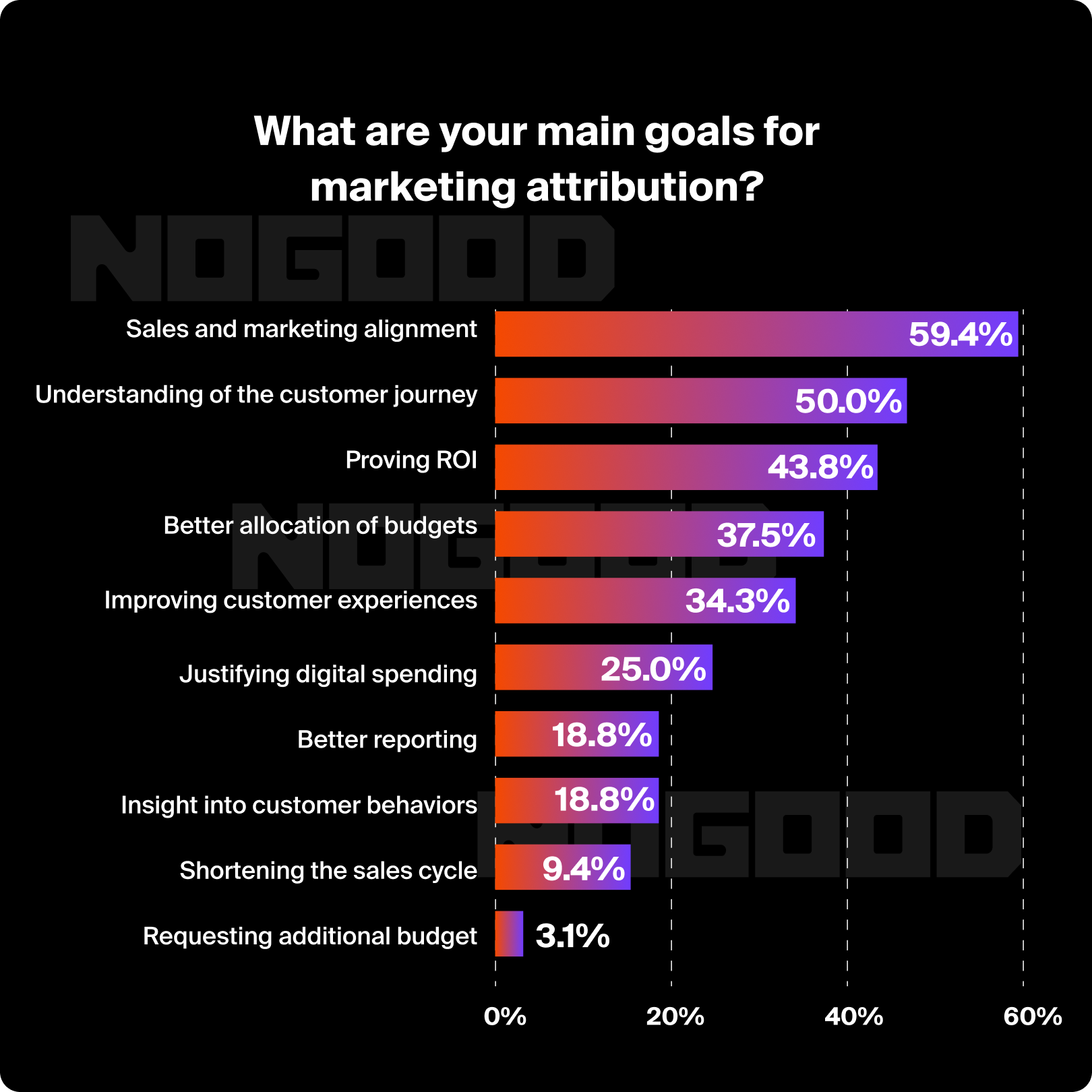
Marketing attribution models help companies determine how their different marketing efforts contributed to the main goal of the business. These learnings then help them make smarter and more efficient decisions to drive business growth. Overall, marketing attribution learnings enable businesses to make smarter and more efficient marketing decisions. Here are a few more detailed examples for the role of attribution in marketing:
- Aligning sales and marketing: 59% of businesses believe that aligning sales and marketing is the primary goal of marketing attribution. This is because attribution helps determine the influence of multiple marketing and sales activities across the customer journey and defines credit at each touchpoint.
- Optimizing marketing spend: Accurate attribution helps marketers understand where they need to allocate their marketing spend. This prevents the overestimating performance of certain channels because of poor attribution or underestimating a channel performance if it’s not correlated directly to conversions. A nice example of this is display ads that are (most of the time) undervalued as a channel. It’s not performing well because it lacks attribution of conversions, even though it acts as the main driver for brand awareness.
- Enhancing Customer Experience: Attribution models provide insights into the customer journey and highlight key touchpoints and potential areas for improvement. By knowing which touchpoints are critical at different stages of the funnel, marketers can communicate in a more targeted and effective way, increasing customer satisfaction and loyalty. Is a middle touchpoint critical to converting? Without marketing attribution, marketers can misjudge the effectiveness of a specific marketing effort.
- Measuring ROI: Attribution is crucial for accurately measuring the return on investment (ROI) of marketing activities. It provides a clear picture of how different channels and campaigns contribute to end-goal. Advanced attribution models can be dynamically adjusted based on real-time data to continuously optimize performance and maximize ROI.
Key Challenges in Implementing Accurate Attribution
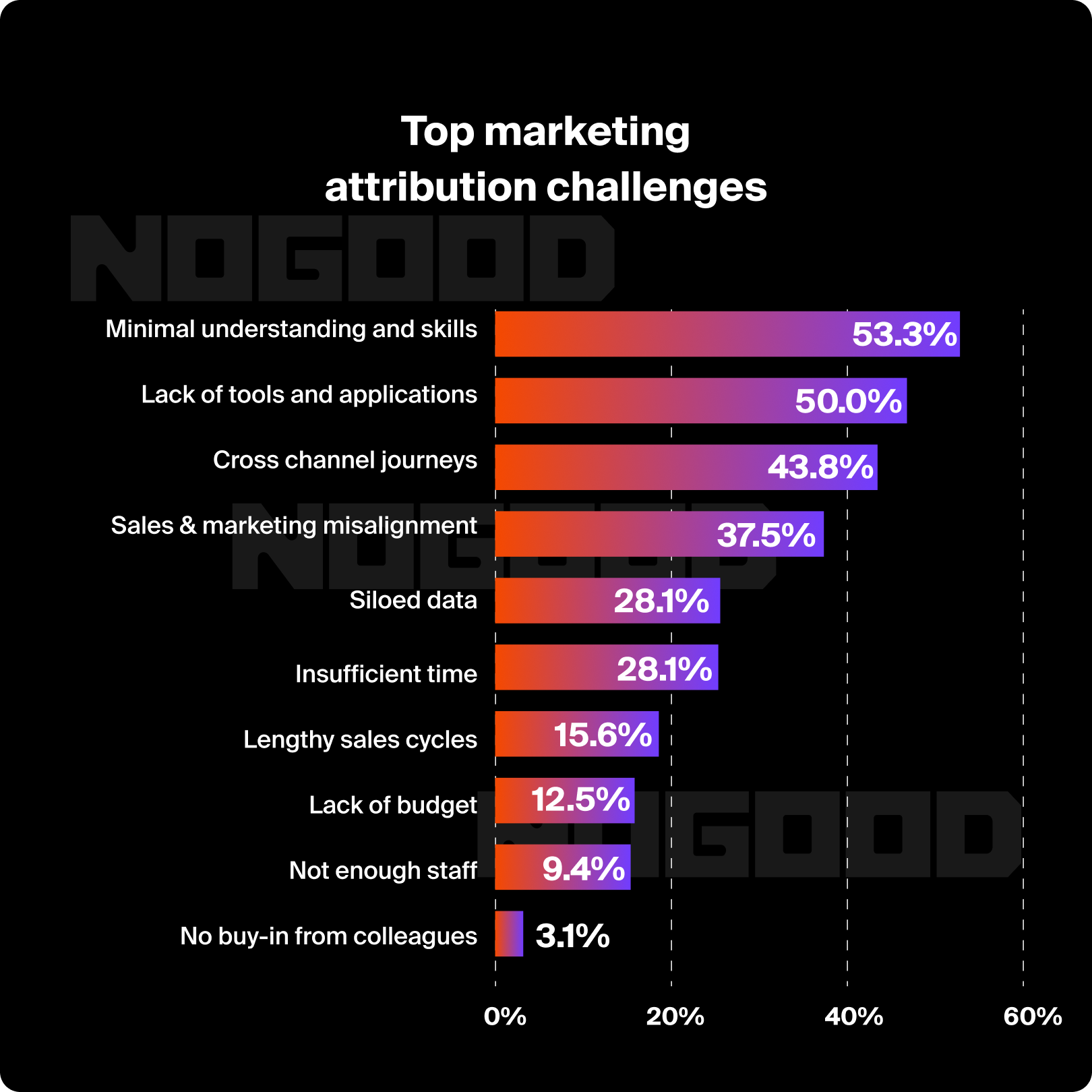
Marketing attribution can be helpful but there are certain challenges when it comes to their implementation:
- Inaccurate or inconsistent data can make attribution ineffective. Therefore, businesses need to ensure that data collection and analysis processes are reliable, consistent, and accurate. High data accuracy can lead to factually correct reports and reliable business results. Accuracy is very important for highly regulated industries such as healthcare and finance.
- Attribution models can be biased due to market or correlation bias when customers who are already interested in a product exhibit behavioral patterns that are falsely attributed to specific marketing touchpoints, leading to inaccurate predictions.
- As GDPR and CCPA tighten privacy regulations, third-party cookies traditionally used to track user behavior across different websites are becoming less reliable, reducing the data available for attribution analysis.
- The complexity arises from the highly individualized customer journeys with various touchpoints and processes that influence customers’ purchasing decisions. The precise allocation of credit becomes increasingly difficult as the number of touchpoints increases. This makes it difficult to determine the specific interactions that most influenced the customer’s final decision.
- Customer data is often scattered across multiple platforms, including website analytics, customer relationship management (CRM) systems, and other tools. This fragmentation makes it difficult to get a unified view of the customer journey and hinders accurate attribution.
Types of Attribution Data
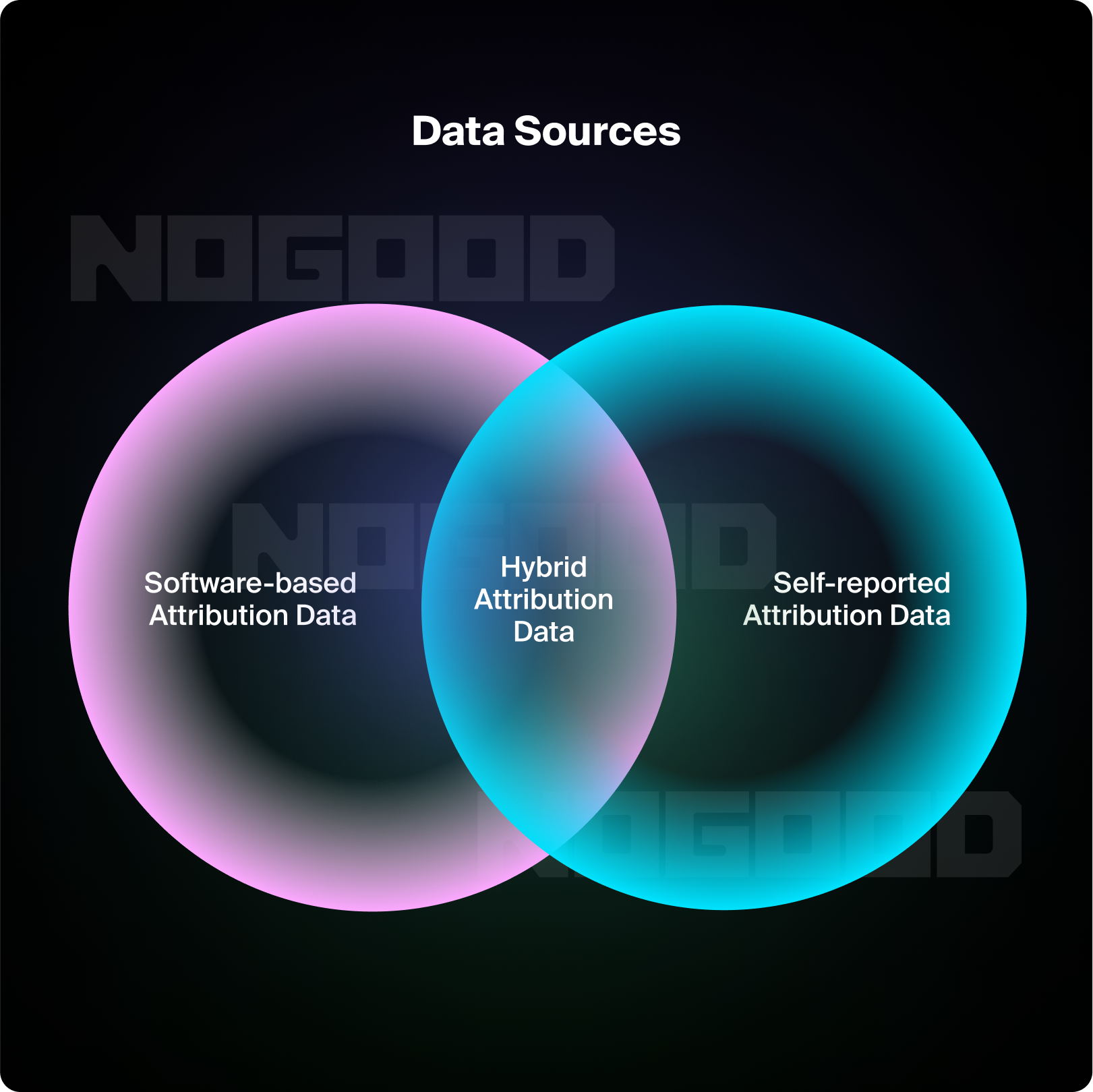
The effectiveness of attribution models is highly dependent on the types and the accuracy of the data that they utilize. The following are the primary sources of attribution data:
1. Software-Based Attribution Data
Software-based attribution relies on digital tracking tools, such as analytics platforms or marketing automation software, to monitor user interactions and attribute conversions to specific touchpoints.
Using software-based attribution data can provide precise, granular data on user behavior and conversion actions, enable real-time tracking and detailed analysis of customer journeys, and reduce the reliance on self-reported data, which can be subject to bias and inaccuracies. On the other hand, using software-based data businesses can miss non-digital touchpoints that aren’t trackable by software. can be complex to implement requires technical expertise for accurate setup, and demands robust analytics tools and proper configuration for reliable insights.
2. Self-Reported Attribution Data
Self-reported attribution data is collected directly from customers, usually through surveys, online forms, or interactions with customer-facing employees. This data reflects the touchpoints customers perceive as influential in their decision-making process.
Self-reported attribution data are useful since they capture qualitative insights and subjective factors that software-based data might miss, such as offline interactions or word-of-mouth, and provide a broader perspective on the customer journey from the consumer’s viewpoint. However, self-reported data can often be many times inaccurate as they are dependent on the willingness of individuals to provide accurate and complete information, there are memory and also perception biases can affect the reliability of the data.
3. Hybrid Attribution Data
Combining software-based data and self-reported data provides a complete view of the customer journey. This hybrid approach used multiple data sources, giving a flutter picture of customer interactions. This improves the accuracy and detail of attribution models.
On the other hand, when businesses choose to use hybrid data, they must apply advanced data integration techniques. This approach ensures that they have what it takes to mix qualitative and quantitative information, and effectively merge the various data sources.
Categories of Attribution Data
Attribution data can be categorized into two main categories including event and channel data. Event data capture the precise activities that users do when interacting with your brand. This type of data includes conversion, behavioral, clickstream, advertising, and CRM data. Channel data identifies where interactions occurred across different platforms and devices. Channel data include referral, device and platform, and offline data.
Types of Attribution Models
Each attribution model offers unique insights into how different touchpoints contribute to conversions. Understanding the different types of attribution models is important to accurately measure the effectiveness of an organization’s marketing efforts. There are several types of attribution models, but companies can also customize their attribution models based on their marketing goals. Understanding the different types of attribution models is important to accurately measure the effectiveness of a company’s marketing efforts. Single-touch attribution models focus on a specific step within the customer journey, while multi-touch attribution creates a complete picture of the customer journey by taking every step into account.
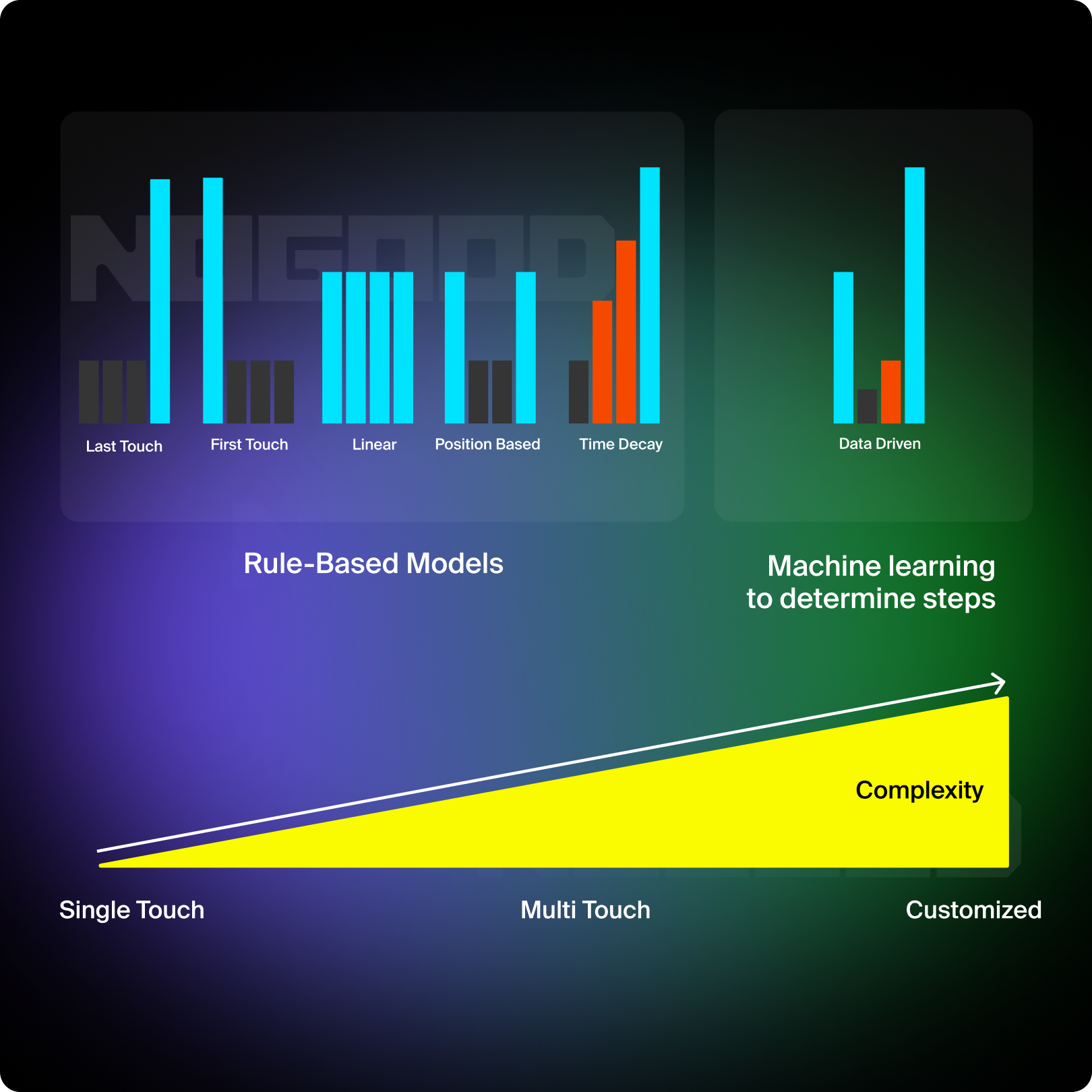
Single-Touch Attribution Models
First-Touch Attribution
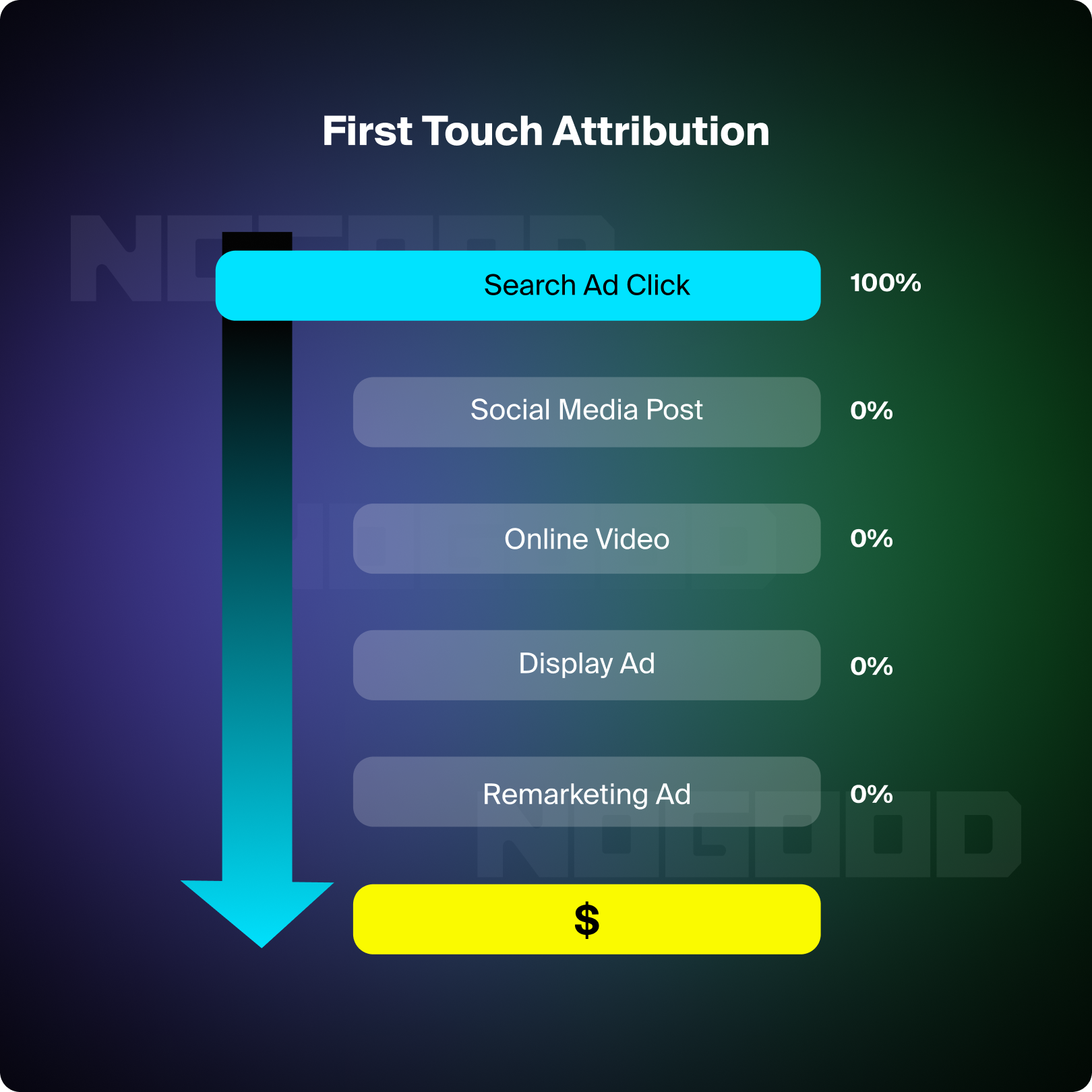
With first-touch attribution, the channel that the customer initiated the first interaction with the brand, such as visiting your website for the first time will count 100% towards that conversion. It is straightforward to understand and implement. First-touch attribution helps brands identify which channels they can use for brand awareness. On the other hand, this model doesn’t consider any mid or last touchpoints that influenced the final goal that your business has set to achieve, which can lead to biased decisions about marketing next steps. Companies with long sales cycles where the initial point of contact is crucial in the buyer’s journey are ideal for using the first-touch attribution model.
Last-Touch Attribution
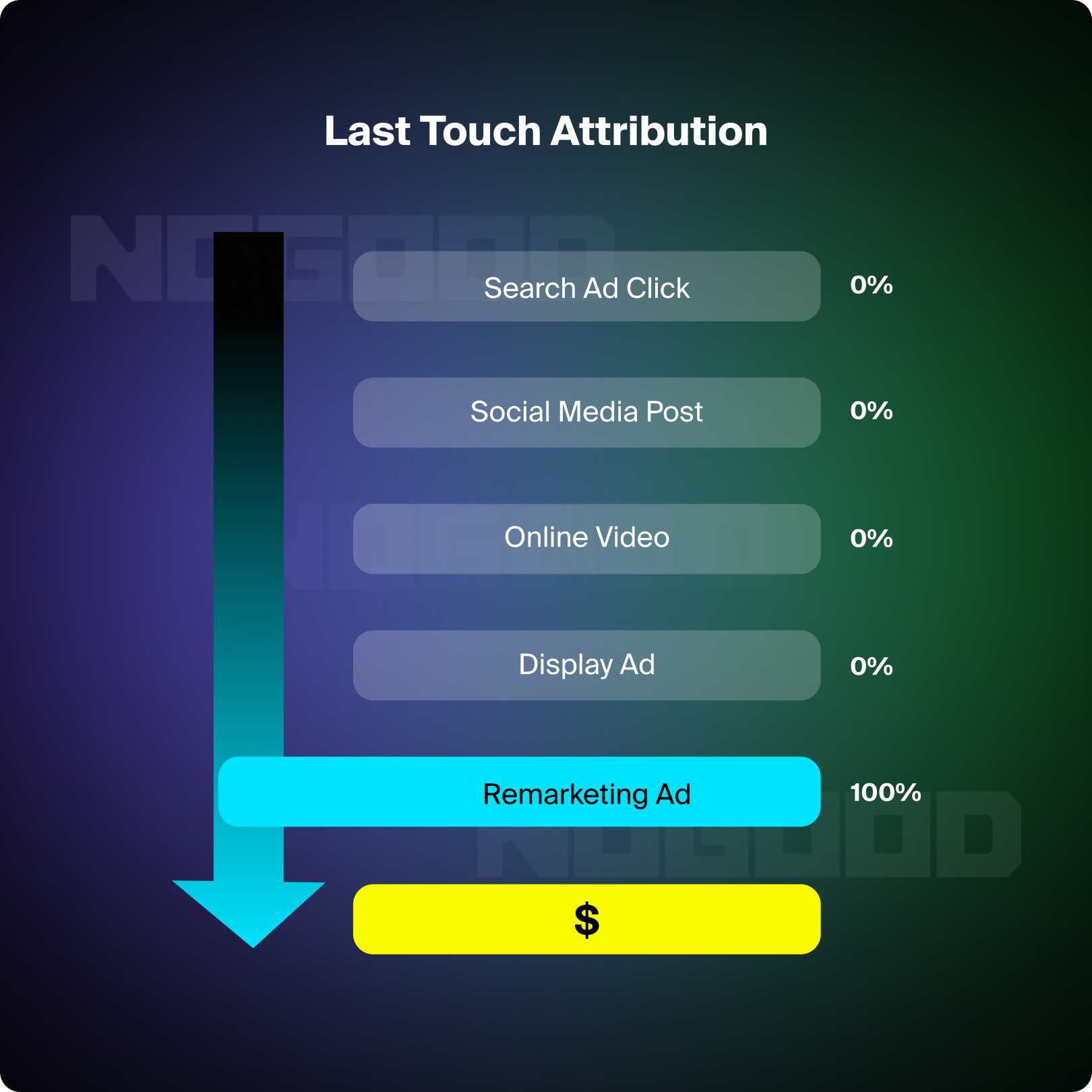
Last-touch attribution gives 100% of the credit to the last user activity before converting. It’s the simplest model to understand the last converting channel, and many companies prefer to use it over other models when they laser-focus on conversions. It’s also useful when there are no complicated customer journeys. On the other hand, though, it completely undermines all the first or middle touch points which are essential for brand awareness and engagement before a user is at the conversion stage. This short-term thinking can lead to missing optimization opportunities and undervaluing long-term brand awareness efforts. This model is only good if a business is laser-focused on conversions.
Multi-Touch Attribution Models
Linear Attribution
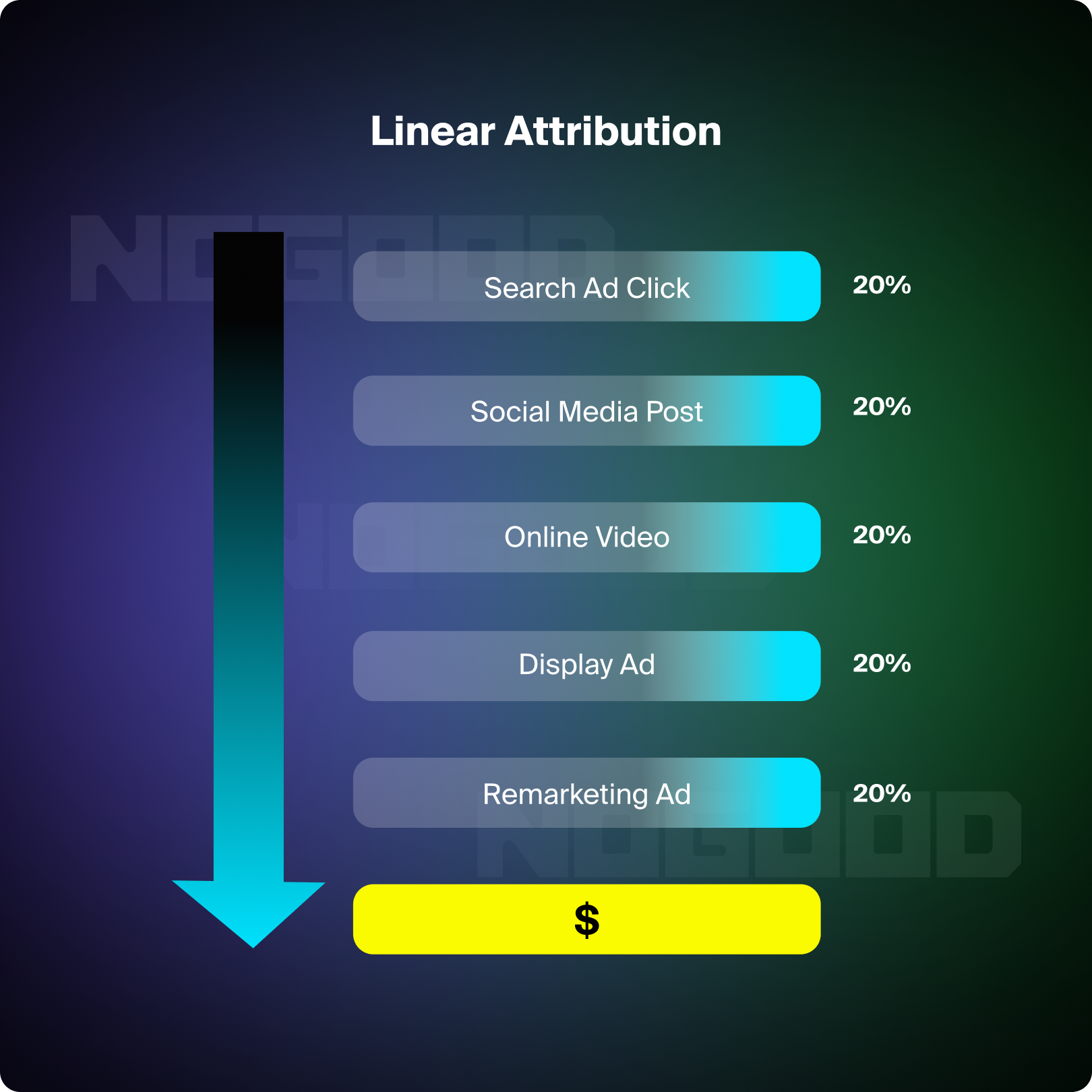
Linear attribution means crediting all touchpoints along a customer’s journey equally. Its best part is that such a model balances all contributing channels and gives a clear view of a customer’s interaction in their entire journey so that any company can understand what works in every stage. It equally values several channels and justifies the spent budget before the final channel. On the contrary, linear attribution is prone to bias if it were based on partial or incorrect data, failing to attribute off-line marketing touchpoints and not considering interaction across devices and touchpoints due to regulatory requirements in privacy, while also omitting external factors such as seasonal channels. Linear attribution assumes touchpoints are independent of one another, but that’s not realistic as for many businesses, the channels that customers interact with directly before making the conversion have the biggest impact on their journey. As a result, using linear attribution may lead to an overestimation of the effectiveness of channels closer to conversion and not an optimal use of learnings to understand the entire customer journey. Linear attribution works best when touchpoints are of equal importance to the overall business goal.
Time-Decay Attribution
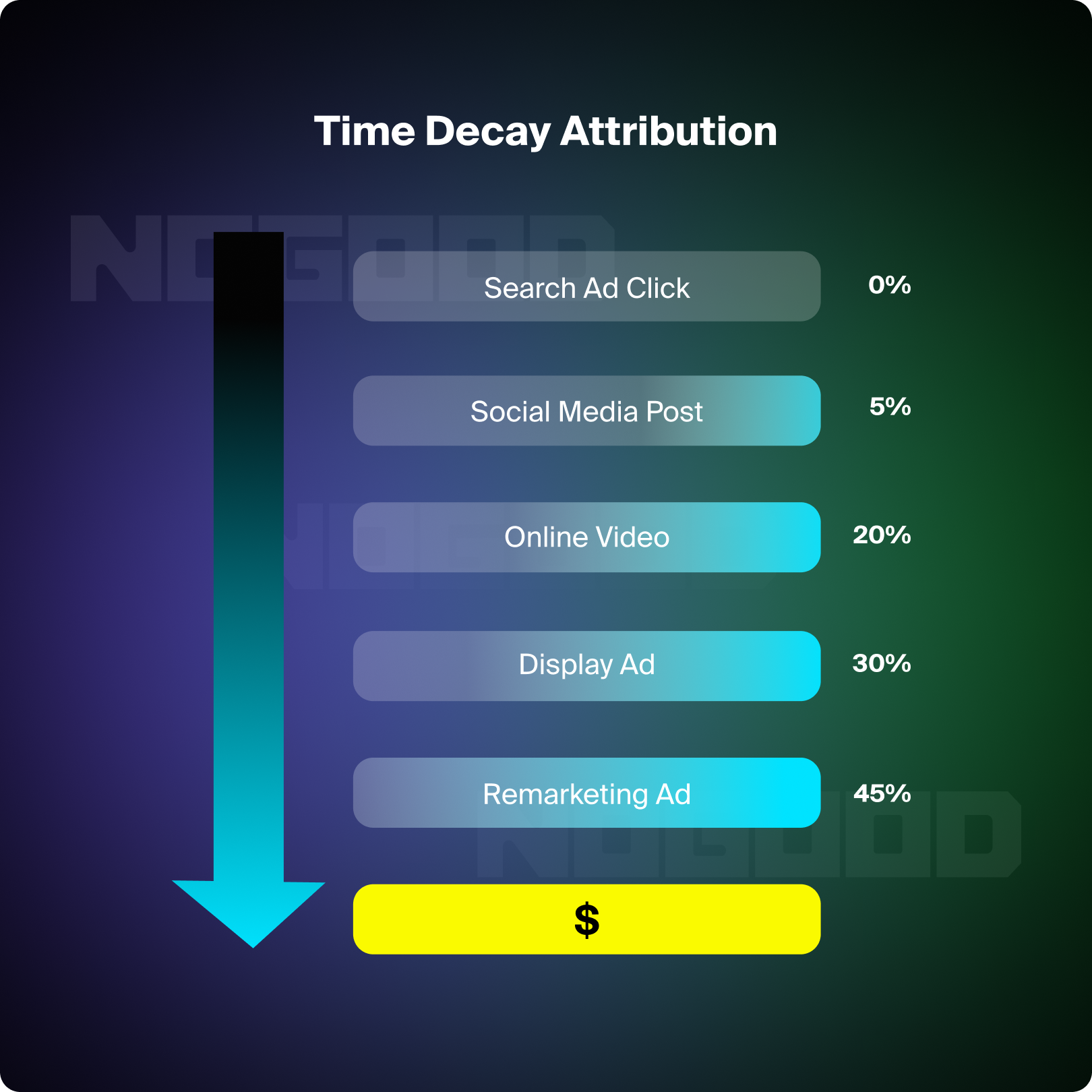
Time-decay attribution credits touchpoints that are closer to the conversion with more weight (45%). This model focuses on the most compelling marketing channels at the critical decision stage and recognizes the role of each interaction throughout the customer journey. In another sense, it helps in identifying the effectiveness of the final persuasive efforts of the customer before converting. It may, however, lead to undervaluing initial interactions that help build brand awareness and therefore using this model can lead to a skewed allocation of resources. It’s not a great use for short sales cycles or impulse buying. Figuring out the ideal decay rate would not be easy, same with the implementation of this model considering its complexity. These complexities could mean that companies at different stages of growth might find it less useful; for considered conversions, it might show a false positive of the value of subsequent interactions. This type of model is most appropriate for longer sales cycles such as in B2B marketing efforts.
Position-Based (U-Shaped) Attribution
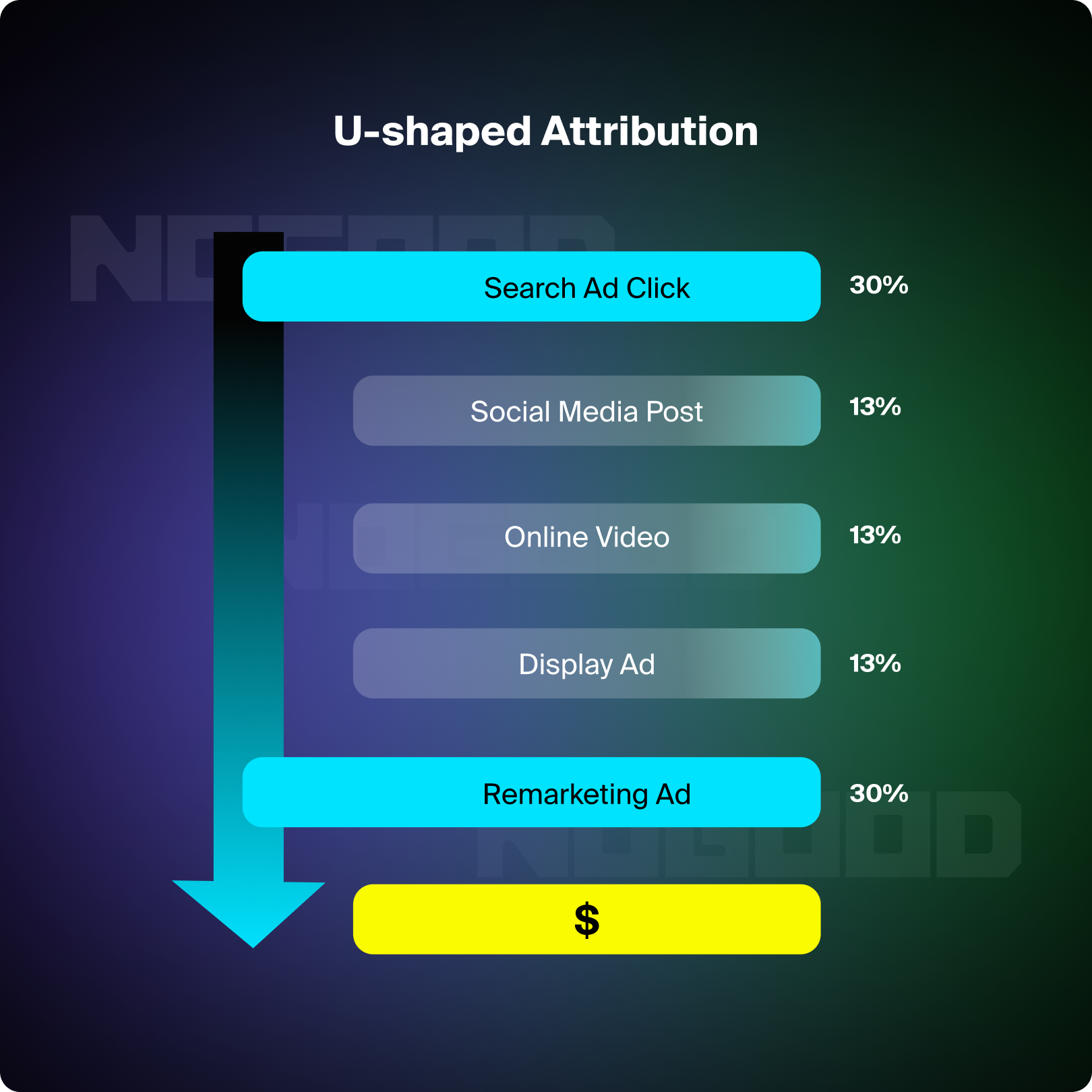
A position-based or U-shaped model gives 40% of the credit to each of the first and last touchpoints and spreads the rest 20% across the middle interactions. Such a model recognizes that customer decisions involve different touchpoints with a brand. It becomes quite helpful in understanding e-commerce metrics like conversion rate, ROAS, and CLV, which give insights into the behavior and liking of the customer. However, this rule is hard to apply in case the customer journey is unclear or spans across multiple channels. Also, it being a model with a fixed 40-20-40 distribution does not represent properly the influence of every touchpoint and it will require much data tracking and advanced analytics. Overemphasizing both the first and last interactions may lead to an underestimation of the middle interactions. This model is the best when businesses seek to focus on specific touchpoints while still seeing the overall view.
W-Shaped Attribution
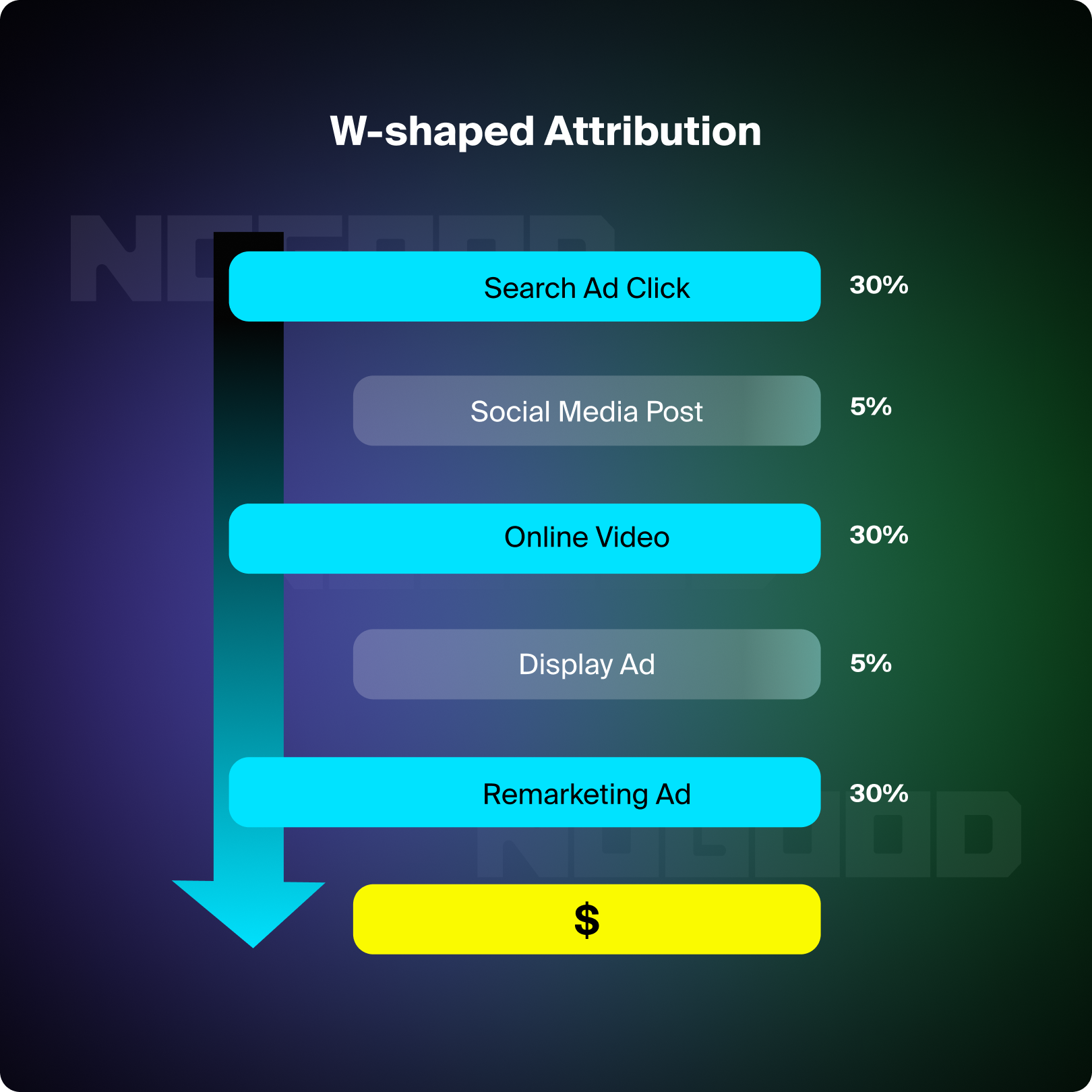
W-shaped attribution is quite similar to U-shaped attribution, though it allocates campaigns proportionately across the complete marketing funnel, providing companies with greater insight into the journey a customer makes. It suits companies with a longer sales cycle that has several touchpoints to involve potential customers in the process. This model is particularly useful for B2B companies where sales funnels are very well-defined and easy to calculate. However, W-shaped attribution focuses on first, middle, and last touchpoints and often does not take into account other valuable interactions. This may give a wrong idea of what actually drives success within the marketing channels, in particular for companies with shorter sales cycles. These models are also much more cumbersome to set up and often make attribution too complicated. For most companies, much simpler models are likely to be more practical.
Data-Driven Attribution
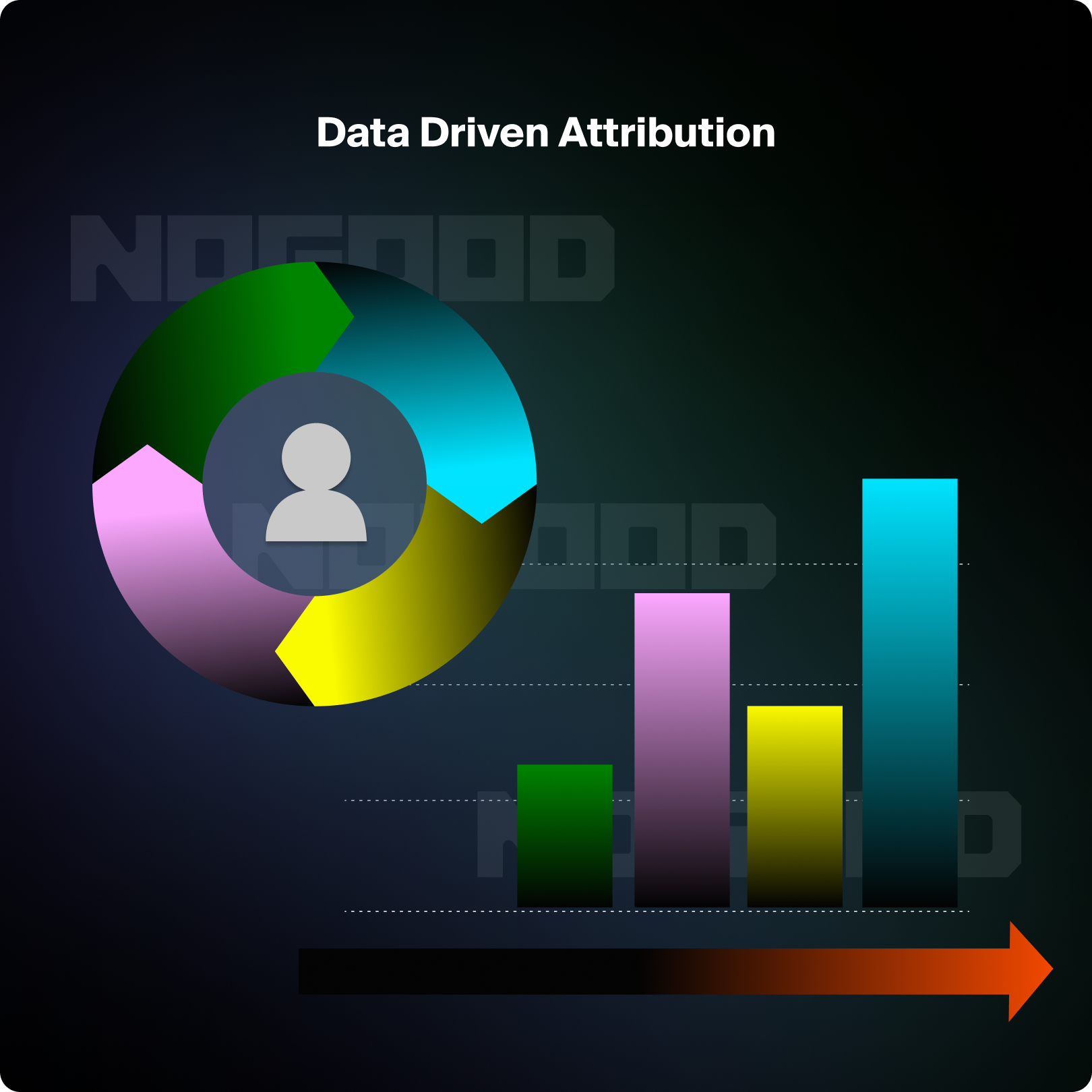
In data-driven attribution, the most influential touchpoints are credited based on customer data using a machine learning model and predictive analytics. In this data-driven model, the algorithm determines which framework works best. This type of model is valuable for complex customer journeys with many touchpoints. Data-driven models are the most accurate and offer unbiased results, but because they are expensive and complicated to implement, they are only accessible to companies that have the budget to bear the higher costs.
Custom Attribution
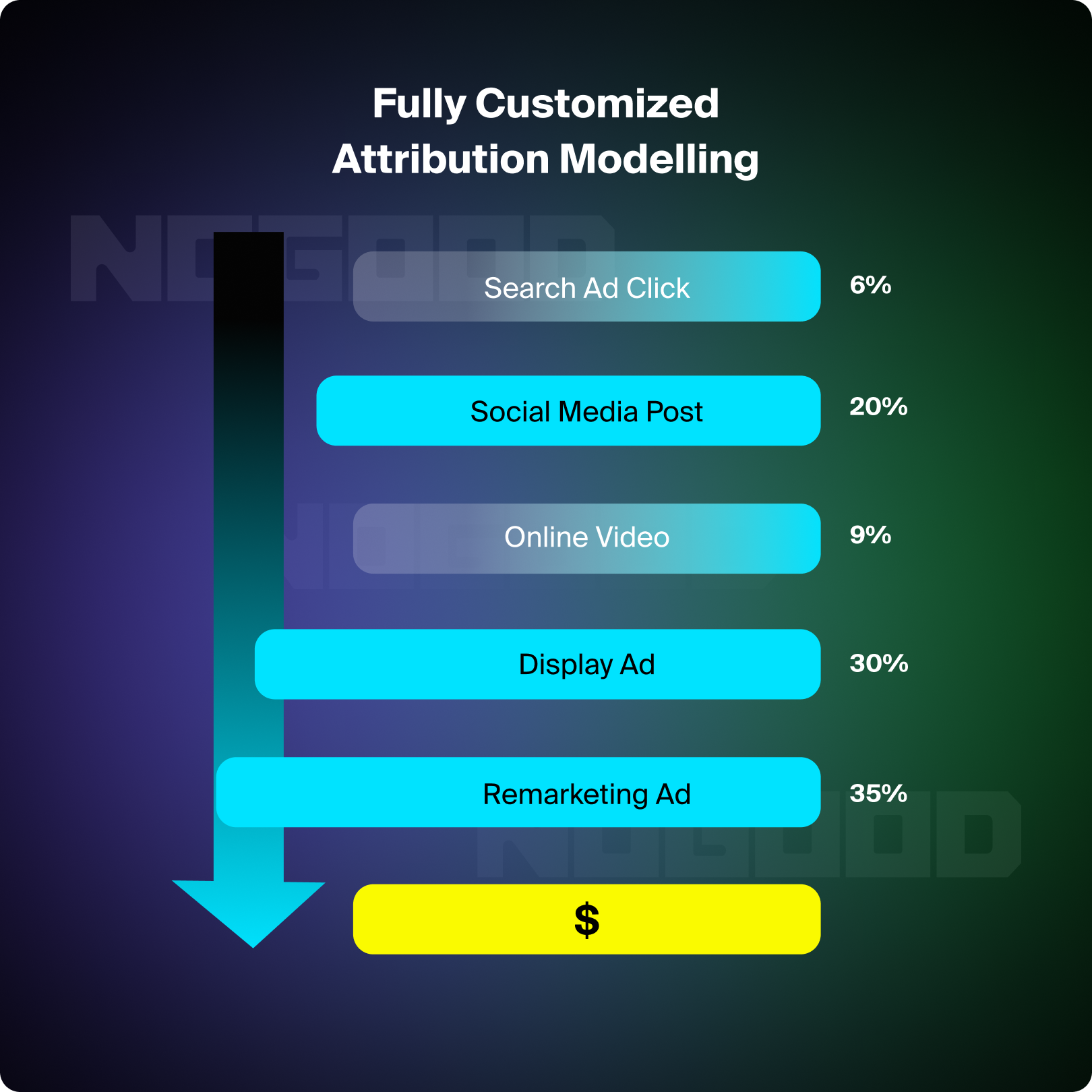
Custom attribution modeling allows your company to set its own rules about how credit is shared among touchpoints in the customer journey. This individualized approach would allow businesses to account for their unique drivers of customer behavior with the brand. Now, companies will be able to better understand what marketing efforts, through this custom model, are driving the conversion and optimizing strategies related to it. This is due to the fact that they are easier for businesses with complex sales processes, those using different marketing channels, or those that have very specific objectives that standard attribution models may not capture well. However, building custom attribution models can become very resource-intensive, requiring sizeable analysis of data, technical expertise, and ongoing maintenance to ensure their accuracy and effectiveness.
Choosing the Right Attribution Model
The attribution model or models you choose should align with your specific business goals and KPIs, so it’s important to select them carefully. Here are some suggestions based on your business objectives:
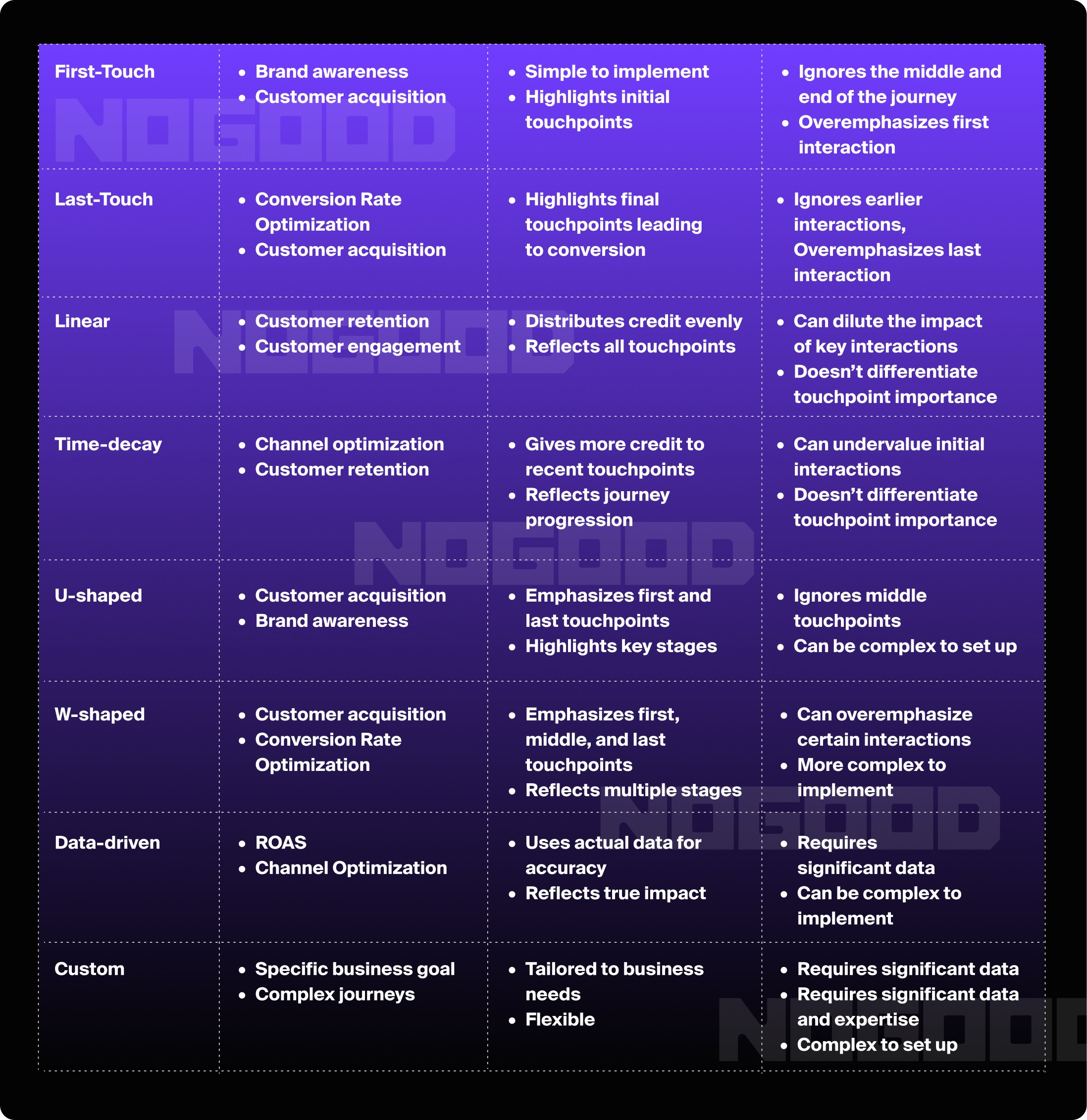
Choosing the right attribution model is crucial for accurately understanding your marketing efforts and optimizing your strategies. Each model has its strengths and weaknesses, and the best choice depends on your specific business needs and goals.
6 Common Misconceptions in Attribution Modeling and How to Avoid
Attribution modeling can be a game-changer for marketers, but it’s often misunderstood. These misconceptions can lead to incorrect conclusions and less effective marketing strategies. Let’s look at some common misconceptions and how to avoid them:
Misconception 1: Last-Click Is Good Enough
Many marketers stick to last-click attribution because it’s simple and seems directly linked to sales. However, this model only credits the last interaction before a conversion, ignoring all the previous touchpoints. This means you could overlook other channels that played a significant role in influencing the customer.
How to Avoid: Use multi-touch attribution models that spread credit across all interactions. These models give a more complete picture of the customer journey and highlight the contribution of each touchpoint. Try out models like linear, time-decay, or data-driven attribution to see which one offers the most accurate insights for your business.
Misconception 2: Attribution Models are One-Size-Fits-All
This is a pretty common misconception as it is not viable to set one attribution model for all your campaigns and business goals. Different approaches are necessary for attribution, depending on the kind of campaign or goal one is dealing with.
How to Avoid: Tailor the attribution model to the objectives and context of your campaign. For example, campaigns directed at increasing brand awareness might benefit from first-touch attribution, while those focusing on conversions could use time-decay or data-driven models. At large, you need to define clear goals for each campaign, while making sure regular reviews are carried out in order to adjust the models as necessary.
Misconception 3: Attribution Equals Accuracy
While attribution models do, in fact, provide a framework for understanding how different touchpoints contribute to conversions, they cannot be 100% accurate without high-quality data. Accurate conversion tracking is necessary before an attribution model can be trusted.
How to Avoid: Make sure that data feeding into your attribution model is accurate, complete, and up-to-date. All you need to do is check consistently for the data sources and remove inconsistencies or gaps to make your attribution right. Easily cured with the appropriate implementation of processes around data validation.
Misconception 4: All Touchpoints are Equal
Frequently, there is a simple illusion that every touchpoint along the customer journey has an equal weight. In fact, there are several very influential interactions. So, once more, it depends on the objective to find the right attribution model. The linear attribution model assumes all touchpoints are equal. It tends to work best when a company has a clear and simple customer journey and uses many marketing channels with relatively short sales cycles.
How to Avoid: Use data-driven attribution models, which can analyze the contribution of each touchpoint based on historical data and real-time interactions if your company has complex customer journeys. This allows for more accurate credit assignment. You can then test adding weights to touchpoints based on their impact on conversions.
Misconception 5: Attribution Models Don’t Need Regular Updates
Most companies establish an attribution model and then ignore it. However, if a business changes its marketing strategy, adds or removes sources of data, or changes its campaign goals, the attribution models need to change as well.
How to Avoid: Regularly evaluate and update your attribution models to accurately represent changes to the customer journey, marketing tactics, and goals. This will help maintain accuracy and relevance. Businesses need to ensure that models are constantly tested and improved to adapt to changing conditions.
Misconception 6: Attribution Modeling is Only About Digital Channels
Even though digital channels are the primary focus, attribution models must consider offline interactions — for example, store visits, phone calls, or events.
How to Avoid: To head off the misconception, integrate offline data with online data to see a comprehensive view of the customer journey. To seamlessly unite offline activities with online interactions, use distinct identifiers and advanced tracking methodologies.
Building Custom Attribution Models
Step 1: Define Clear Objectives
The first step in creating a custom attribution model is to establish clear objectives. Objectives may be different for different channels, or for different segments of your target group, and will guide you to create a custom attribution model that meets your company’s needs.
Step 2: Determine Conversion Events
For each of your goals, you should define what a conversion is. A conversion is essentially the key activities or events that tell you that the user journey is successful at every step. Including post-view and post-click data will help you understand the overall view of your user’s journey. Post-click attribution takes the user from when the user clicks on an ad to the user’s last purchase. Post-view attribution can be used to track a conversion that happens after a user views an ad but doesn’t necessarily click on it.
Step 3: Set Relevant Lookback Windows
A lookback window is the amount of time you’d like to include for interactions to count toward the conversion event. This is an important setting, as you’ll want to make sure your attribution model is reflective of the customer’s journey and all of the different touchpoints that influenced it.
Step 4: Weight Touchpoints Appropriately
Assign different weights and importance levels to different touchpoints based on their strengths. You should continually review and validate how important each touchpoint is and change them based on your touchpoint and customer objectives. Based on the KPIs and marketing objectives of the activity, you should at a minimum annually review and adjust the weight. Revenue attribution should be incorporated in your weighting to improve the success of the campaign and increase ROI.
Step 5: Weight Touchpoints Appropriately
Any custom attribution model should be tested regularly and refined based on learnings from testing. Testing will involve learning from A/B testing or other experimental methods if the weighting and attribution are correct. Regular checking on the attribution model ensures the correct weighting is retained and will also ensure precision.
Step 6: Utilize Advanced Tools
If your organization does not have the data science or engineering capacity, utilize vendors or tools to implement the attribution, Lifesight, Rockerbox, Signal AI, and Northbeam are some vendors that can help with attribution. Google Analytics is also useful but may over credit Google channels over other paid solutions and demonstrate a bias towards Google advertising.
Step 7: Test and Iterate
Continue to test your attribution model and keep on refining it. Adjusting weights and methodologies to improve your model’s accuracy and reliability. Testing your model sequentially is a method to ensure that your models remain accurate and relevant. Lift tests and incrementality tests are also effective in measuring how your campaigns had an impact.
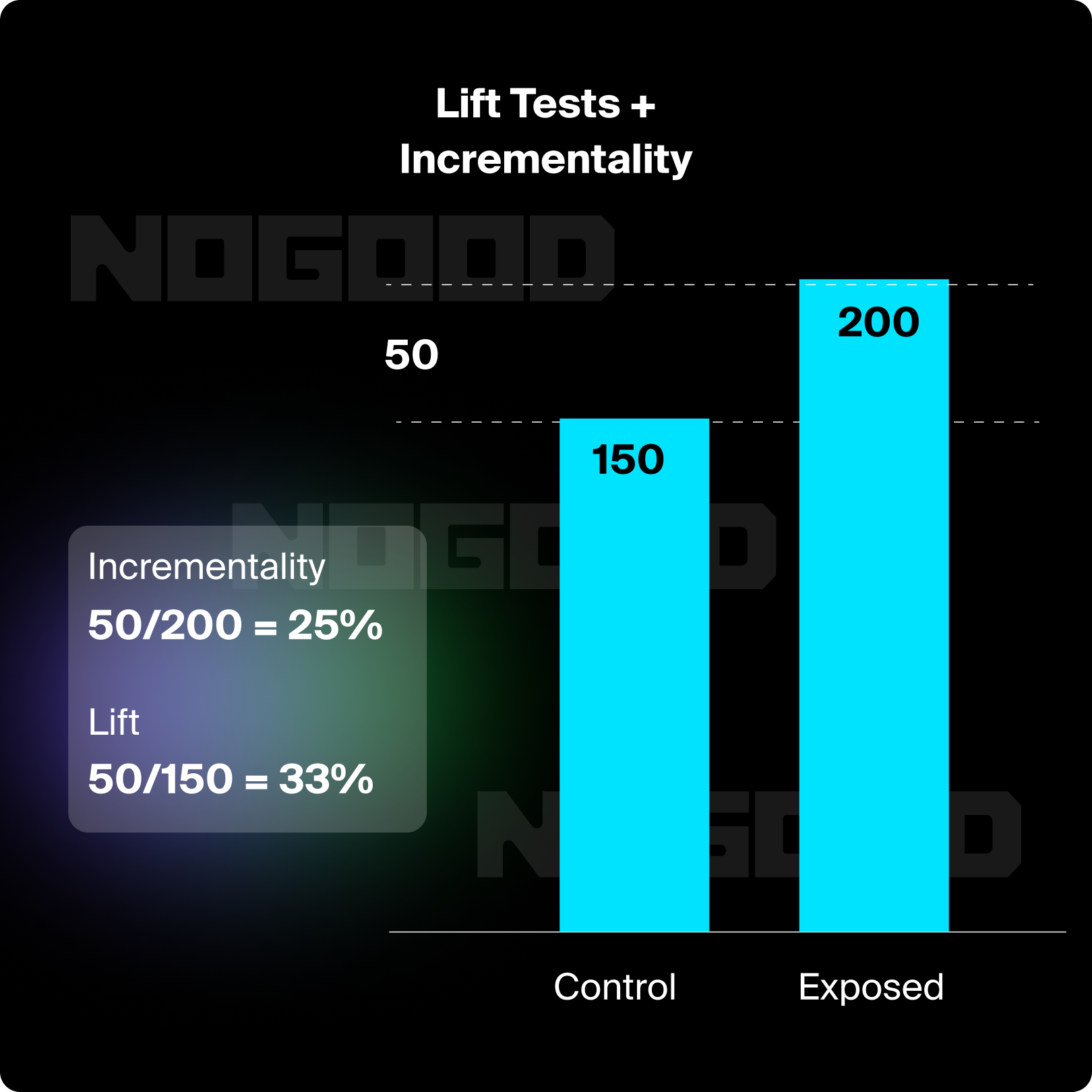
If you want to improve your marketing attribution, it is important that you first agree with everyone involved about the goals that you want to achieve in your organization. Understanding the questions that need to be answered will help you define the attribution models and methods you can choose from. Before you commit to a particular approach, evaluate your team’s capabilities. Although custom attribution gives you the best picture of your customers, it can be a complex process. Either opt for an out-of-the-box solution or choose to create your customized attribution model.
Attribution is not just about deriving data, but rather using scientifically validated approaches to understand the impact of different attribution models on business goals and KPIs. By selecting the right data and methods and maintaining a flexible, adaptable approach, you can gain a more accurate and actionable view of your marketing effectiveness, ultimately leading to better decision-making and higher ROI.






